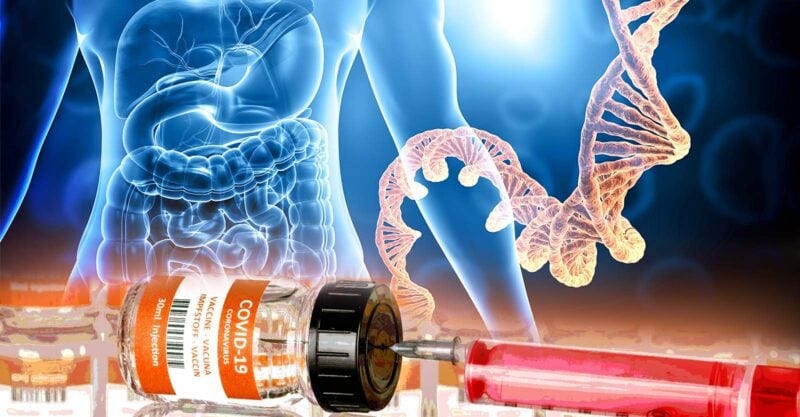‘Alarm Bells’: Genetic ‘Fingerprint’ of COVID Vaccine Found in 31-Year-Old Cancer Patient’s DNA
The reality is darker than anyone imagined.
This article originally appeared on The Defender and was republished with permission.
Guest post by Michael Nevradakis, Ph.D.
A new preprint study presents the first direct evidence that genetic material from mRNA COVID-19 vaccines can integrate into the human genome, potentially triggering aggressive cancers, according to the authors. The findings contradict assurances that the shots cannot alter DNA or carry harmful DNA fragments.
Genetic material contained within mRNA COVID-19 vaccines can integrate into the human genome, potentially contributing to the onset of aggressive cancer, new research suggests.
“We believe this is a warning signal the world cannot afford to ignore,” said epidemiologist Nicolas Hulscher, one of the co-authors.
The study’s results contradict claims by vaccine manufacturers and public health agencies that the mRNA COVID-19 vaccines can’t alter human DNA and are not contaminated with DNA fragments, according to Hulscher.
The preprint study was published on Monday on Zenodo, an online research repository operated by CERN, the European Organization for Nuclear Research.
It is the first study to present direct evidence of genetic material integrating into the human genome, according to the authors.
‘This pattern is biologically plausible for accelerating cancer progression’
The study focused on the case of a previously healthy 31-year-old female who developed “rapidly progressive stage IV bladder cancer” within a year of receiving three doses of the Moderna mRNA COVID-19 vaccine. The case was described as “an unusual and aggressive presentation for this age.”
According to Hulscher, the study found that her vaccination led to a series of adverse events that likely led to the onset of cancer. He said:
“We saw a perfect storm — genes that normally drive cancer were switched on, genes that normally repair DNA were broken, and broad disruptions in cell signaling were present across every biospecimen we tested. All of this emerged within a year of her mRNA vaccination series.
“Taken together, this pattern is biologically plausible for accelerating cancer progression.”
The study revealed that a fragment of genetic material in the patient matched100% with a sequence contained within the spike protein portion of the Pfizer-BioNTech mRNA COVID-19 vaccine.
Although the patient received only the Moderna vaccine, Hulscher wrote that the two vaccines “share identical stretches of nucleotide sequence” within the spike protein.
Moderna’s “proprietary plasmid sequence has not been deposited in NCBI” — a U.S. government database — so the Pfizer vaccine was identified as the closest match, the authors said.
According to the study, the odds of such a fragment being a 100% match with a sequence contained within the vaccines are approximately 1 in a trillion.
It “should set off alarm bells” that this match occurred amid widespread cell mutation in such a rare and aggressive cancer, Hulscher said.
DNA contamination can lead to adverse health effects, including multiple cancers and the potential onset of turbo cancer, chronic inflammation, and a higher risk of blood clots, strokes and sudden death. DNA contaminants may also be passed on to children.
Hulscher said:
“For years, regulators insisted integration was impossible. Our study is the first direct molecular evidence of vaccine-derived DNA embedded into the human genome. And it wasn’t a random event: it occurred alongside evidence of cancer-driving mutations and genetic chaos.”
‘We found a genetic fingerprint of the vaccine inside her DNA’
According to the study, the 31-year-old patient was selected because of her rare diagnosis.
Bladder cancer is “predominantly a disease of older adults, and its occurrence in young women is exceptionally uncommon.” When it does occur, “it is typically aggressive and carries an unfavorable prognosis,” the preprint states.
Study co-author John A. Catanzaro, Ph.D., a naturopathic doctor and CEO and co-founder of Neo7Bioscience, said the average age of patients with a bladder cancer diagnosis is 73. Fewer than 2% of cases occur in people under 40. In women under 35, “it is extraordinarily uncommon — estimated at well below half of one percent of all diagnoses.”
“Given the rarity of advanced bladder cancer in this demographic, her case warranted in-depth molecular investigation,” the study states.
Among young women, most bladder cancer diagnoses involve low-grade and non-muscle-invasive tumors “that are usually detected and treated before spreading,” Catanzaro said. He added:
“By contrast, Stage IV (metastatic) bladder cancer in a woman in her early 30s is an extreme outlier, documented mainly in isolated case reports. Such advanced disease at this age falls far outside the usual epidemiologic pattern and underscores the highly unusual nature of this patient’s presentation.”
The patient, who is still alive and “under active treatment with a personalized targeted therapeutic design,” did not have a personal or family history of cancer and was “identified through routine molecular surveillance during her ongoing treatment,” Catanzaro said.
Through data derived from her treatment, Neo7Bioscience performed a multi-omic analysis, which Catanzaro defined as “a four-layer molecular scan of the patient’s cancer and blood.”
This analysis included a circulating tumor DNA analysis, or “liquid biopsy,” to detect “tiny fragments of tumor DNA in the bloodstream” and functional exome sequencing, which is a “close look at the key working sections of her genes to spot important mutations,” according to Catanzaro.
The analysis also included RNA transcriptome profiling — “a check of which genes are actively turned on or off inside the cells” — and an excretion proteome analysis, or “examination of proteins released in urine and other body fluids to show how the tumor and the body are behaving.”
According to the study, mRNA vaccines introduce “heavily modified RNA molecules and lipid nanoparticle carriers” into the body, posing a risk of genomic disruption and oncogenic — or cancerous — development.
Lipid nanoparticles can deliver DNA from the vaccine throughout the body.
Karl Jablonowski, Ph.D., senior research scientist at Children’s Health Defense, said vaccine manufacturers initially claimed the lipid nanoparticles wouldn’t spread beyond the vaccination site. He said:
“Knowing the dangers that DNA would pose if it were encased in a lipid nanoparticle, manufacturers attempted to destroy the DNA using an enzyme called DNase. Not only did the DNase fail to break down the DNA, the manufacturers didn’t check. The DNA was encased in the lipid nanoparticle, and is now found in the cancer cells.
“The fallout of recklessness is not just that one person now has cancer from the mRNA injection. The implication is that investigating the roots of all cancers in all vaccinated people must entertain the possibility of vaccine origins.”
Hulscher said the study’s findings confirmed this risk in the patient.
“We found a genetic ‘fingerprint’ of the vaccine inside her DNA … in a gene-dense and unstable region,” Hulscher said. “This integration site was not in a benign ‘safe harbor,’ but in an area where disruption could affect many other genes.”
According to the study, this integration has “oncogenic potential” and tumor-producing potential, leading to “a permissive landscape for aggressive malignancy.”
Hulscher said the mRNA vaccines have several possible mechanisms that could lead to such an outcome. The most plausible explanation is carry-over of plasmid DNA fragments from the manufacturing process — billions of which have been quantified per dose, he said.
“Other biologically feasible mechanisms exist, such as reverse transcription of Spike mRNA by endogenous enzymes followed by integration, or indirect genomic instability triggered by chronic spike protein exposure,” Hulscher added.
‘Humanity cannot gamble with genomic disruption’
The study cites a peer-reviewed paper published earlier this month in the journal Autoimmunity that identified billions of residual plasmid DNA fragments per dose in the Pfizer and Moderna mRNA COVID-19 vaccines.
Other recent studies have also identified DNA contamination in the mRNA vaccines and the potential health harms it may cause. These include:
A 2023 finding by Kevin McKernan, chief scientific officer and founder of Medicinal Genomics, identified DNA contamination in the Pfizer mRNA COVID-19 vaccine — a discovery later confirmed by others, including Health Canada, a government agency overseeing that country’s health system.
A peer-reviewed study published last year in the journal Science, Public Health Policy and the Law, found DNA in Pfizer’s COVID-19 vaccines at levels three to four times higher than regulatory limits.
A peer-reviewed study, published last year in the journal Methods and Protocols, found DNA impurity levels ranging from 360 to 534 times higher than the regulatory limit.
A study performed last year at a U.S. Food and Drug Administration (FDA) laboratory by high school students under the supervision of FDA researchers confirmed the presence of a high level of DNA contamination in Pfizer’s mRNA COVID-19 vaccine.
A literature review published earlier this year identified over 100 peer-reviewed studies indicating that mRNA COVID-19 vaccination may lead to turbo cancer, through 17 distinct biological mechanisms.
Hulscher said the new study “closes the loop”:
“Other teams documented plasmid DNA contamination in the mRNA shots; we show that those fragments can likely integrate into a human genome.
“Separately, oncogenic driver activation has been observed in association with Spike exposure; here we show both plasmid integration and widespread oncogenic dysregulation happening together in a real patient.”
The study notes that while causality “cannot be established from a single case,” the convergence of factors identified in the study “represents a highly unusual and biologically plausible pattern” connecting the mRNA vaccines to genomic integration and cancer that warrants further study.
“Stage 4 cancer is now a documented adverse reaction explainable only by vaccination, and it’s necessary to include oncogenesis while obtaining informed consent,” Jablonowski said.
The study’s findings also strengthen calls to suspend or withdraw mRNA vaccines, as their health risks are not fully known, Hulscher said. He added:
“Before now, integration was dismissed as impossible. Our findings demonstrate it can happen, in a dangerous region of the genome, with clear functional consequences. That demands immediate market withdrawal.
“While more research is needed to quantify frequency and risk, precautionary suspension is justified. Humanity cannot gamble with genomic disruption.”
Related articles in The Defender
DNA Contamination in Pfizer COVID Vaccines Up to Four Times Legal Limits, Study Finds
DNA Contamination in Pfizer COVID Vaccine Exceeded 500 Times Allowable Levels, Study Finds
DNA Contamination in Vaccines: What Is It and Why Does It Matter?
Donate to Children’s Health Defense



Thank you for sharing.
I know a case of cancer after vaccination from work.
And two leading doctors told him that they couldn’t speak freely in their position but the see a strong raise of cancer since the vaccination.